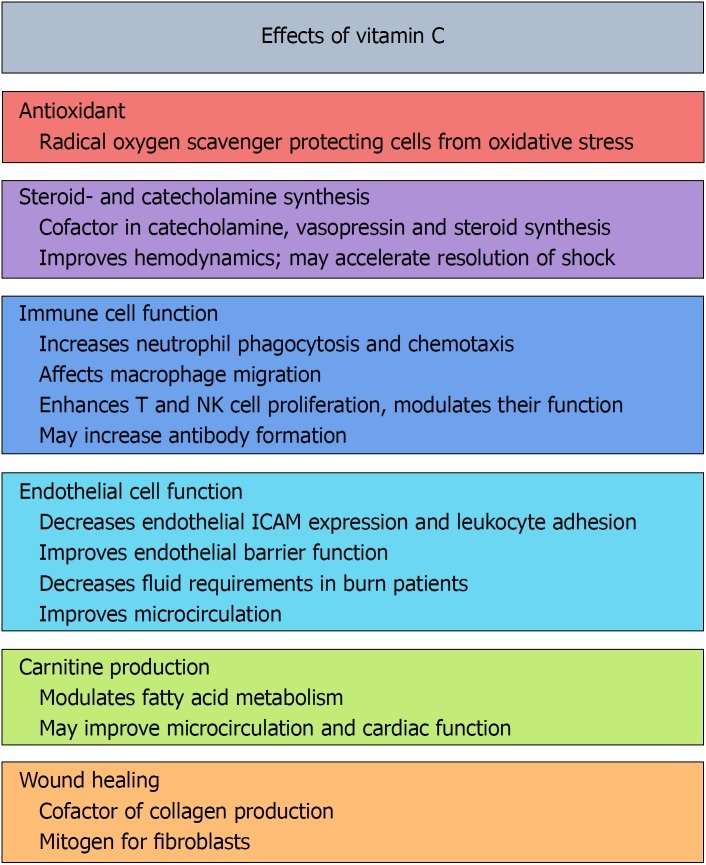There has been research exploring the uses and benefits of vitamin C for almost 100 years.
The data has shown it can reduce infection, reduce fatigue, improve quality of life and more with almost no side effects. Not convinced? Read on and “C” for yourself.
What is Vitamin C?
Vitamin C is a water-soluble vitamin and antioxidant. It is famous for collagen synthesis, cell energy, metabolism, immune support, enzyme activation and hormone production. Did you know it’s needed for making serotonin in the brain? Serotonin helps the brain feel happy, create memories, think, and so much more. Did you also know that vitamin C recycles and renews your glutathione? Glutathione is an antioxidant needed for body detoxification. Being able to get rid of toxins is vitally important in keeping you healthy!
Vitamin C is also a powerful antioxidant.
It is an antioxidant because biochemically it can donate electrons to reactive oxygen species (ROS) in the body. ROS are harmful but necessary substances in the body that need to be kept in balance. When there is more inflammation in the body, there are more ROS, and antioxidants like vitamin C become more important for keeping you healthy. Antioxidants are important because they protect your vital structures like cell proteins, lipids and DNA from damage.
Vitamin C is found in plant foods such as citrus fruits, other fruits, green leafy vegetables and more. It is considered an essential vitamin because humans don’t produce their own. Theoretically, we should get it in a balanced diet, yet there may be times we are deficient due to low intake or increased need in the body.
Vitamin C is beneficial against infection and fatigue
Because illness increases inflammation and antioxidants decrease inflammation, researchers have explored antioxidant use in sick people. Remember how we don’t produce our own vitamin C and there are times, like when we are sick, that vitamin C gets used more? Studies found people in hospital ICU centers were extremely deficient in vitamin C, despite being given standard oral and IV nutrition that should have given adequate amounts of vitamin C. (See the study that measured the levels or the meta-analysis review of 18 ICU studies.)

Many of the high-risk, viral-infected patients end up in the ICU for intensive treatment for a variety of reasons. There is data that showed vitamin C can shorten patients’ length of an ICU stay and decrease the duration of mechanical ventilation. There has also been data showing patients in the ICU had better chances of survival when given vitamin C. As an ICU stay is highly costly to the hospital and patient — not to mention beds may be in short supply — even a moderate reduction in length of stay is worth exploring, especially when the treatment in question is relatively low in cost and can significantly impact mortality.
It is already established that vitamin C supports various parts of the human immune system, including making lymphocytes and supporting the antimicrobial activities of natural killer cells. There are studies showing that vitamin C increases lymphocyte white blood cells, decreases replication of viruses, as well as animal research showing increased resistance against viral and bacterial infection when given vitamin C. Plus vitamin C is found in high concentrations in immune cells called phagocytes and lymphocytes compared to low amounts in plasma, so researchers know it is playing a role in these immune cells’ functions.

Vitamin C has directly been studied in pneumonia. In World War II, an 80% or more reduction in pneumonia was found in those who were given vitamin C. Another large review article discussed three large vitamin C prevention trials with statistically significant reduction in pneumonia incidence.
The common cold can be caused by several viruses and has been studied many times with vitamin C. Thirty-one studies have found regular vitamin C intake reduced duration and severity of colds. Other studies found that the common cold was significantly reduced in groups like male schoolchildren with vitamin C supplementation. Vitamin C also reduced the number of “chest colds” in women and number of “throat colds” in research. ]
The research indicates vitamin C for prevention of viral respiratory infections can be a worthwhile investment.
There is also specific data for the use of vitamin C against fatigue. A study explored IV vitamin C against fatigue in office workers. The treatment group was given 10g of vitamin C by IV, and the control group was given IV saline. They found IVC reduced fatigue without side effects. The trial also reported the vitamin C group had lower oxidative stress compared to the control group, showing IV antioxidants are helpful and versatile!
Why are there a range of vitamin C doses?
The dose of a medication or a nutrient is directly related to the effect it has on the body. This is why there are dosage instructions for virtually every drug or supplement you have ever seen. If you take too little of something, you won’t have enough of an effect, and if you take too much of certain things, it can have unwanted effects. Vitamin C can be given in antioxidant dosages and pro-oxidant dosages. There is no standardization around the terms “low dose” and “high dose” vitamin C, so to avoid confusion we refer to it as antioxidant vs pro-oxidant. Ten grams or less is considered a non-oxidative or antioxidant dosage. Studies in the oncology field have found antioxidant dosing can be used to decrease fatigue, pain, nausea, vomiting, appetite loss and insomnia. In fact the evidence shows it can increase overall health and functioning in these patients.

At the higher pro-oxidative dosages of vitamin C, such as over 10g, there is evidence that the mechanism of the nutrient is different. Not to get too biochemical on you, but at this dosage the C acts to reduce metal ions, and the reduced transition metal ions can then generate hydrogen peroxide and cause oxidative stress. Hydrogen peroxide is a pretty strong substance that you may know as a household antiseptic. Well, the body can make it too when given certain tools. The reason behind pro-oxidative vitamin C dosing (10g and higher doses) is for pro-oxidant activity.
IV vs Oral vitamin C
There have been studies that look at both forms of intake: oral and IV. When we talk about higher dosages like 10g and more, the only way to achieve these dosages is through IV due to system saturation, enzyme availability and potential side effects. When we eat vitamin C, there is a specific enzyme in the digestive tract that needs to transport it across into the system; it’s called SVCT1. It has factors that limit oral absorption of vitamin C such as limited amount, saturation, and its sodium dependency. The IV vitamin C doesn’t need this transporter because it doesn’t use digestion but bypasses digestion altogether.
It has been shown that when higher dosages of vitamin C are attempted with oral intake, side effects can happen like abdominal pain and diarrhea. This doesn’t happen with the IV higher dosages because it doesn’t work through the digestive tract; it is delivered straight into the bloodstream.
IV vitamin C is used to achieve higher doses in the body – and does so more efficiently. With oral vitamin C intake, we don’t see greater than 200μmol/L of vitamin C in the blood plasma. But IV vitamin C can give plasma concentrations of 20mmol/L. That’s a 100x difference!

Vitamin C Safety
There is extensive safety research in both oral dosing and IV treatments of vitamin C. Vitamin C reviews suggest there is little chance of taking too much of the vitamin to be harmful in the normal population. They only found GI upset, as discussed above, when more than 2-4g of vitamin C are taken orally (not IV). There is no evidence that vitamin C alone in any form is harmful in pregnancy or causes reproductive harm. Over the decades that vitamin C has been used intravenously, very few side effects have been seen. In nearly 1,000 patients studied, only 1% had side effects, which were mainly fatigue.
The risks of vitamin C occur in two very specific populations: those with kidney diseases and those with a genetic deficiency called G6PD. This is why this IV treatment needs to be administered by a healthcare provider who understands physiology, biochemistry, and clinical data. You need to be properly screened to ensure you are a good candidate to receive it.
But won’t you just pee vitamin C out?
Many skeptics state that water-soluble vitamins like vitamin C taken in high doses get passed into the urine, so taking large doses are pointless. Yet the studies have found that there can be benefits when taking the higher doses in times of need, such as a cold or flu. One study saw this when they looked at high-dose vitamin C in the prevention and relief of viral respiratory infections. In the evaluation of 715 students, the test subjects received high-dose vitamin C and the control subjects were given pain relievers and decongestants. They found those who received the high dose of vitamin C had 85% fewer symptoms compared to the controls.
It’s important to remember that humans don’t make their own vitamin C, can’t store vitamin C, and have been found to have lower levels when they get sick. When the body is under stress, like during an illness, more vitamin C can be taken to support the depleted levels, help combat illness, and prevent deficiency.
Additional Resources
- The Science Behind Vitamin C
- Don’t Just Avoid the Virus — Defeat It by Strengthening Your Immunity
- Can early and high intravenous dose of vitamin C prevent and treat disease
Sources
- Anderson TW, Reid DBW, Beaton GH. Vitamin C and the common cold. Canadian Medical Association Journal 1973;108(2):133.
- Carr, A. C., & Cook, J. (2018). Intravenous Vitamin C for Cancer Therapy – Identifying the Current Gaps in Our Knowledge. Frontiers in physiology, 9, 1182.
- Carr, A., and Frei, B. (1999). Does vitamin C act as a pro-oxidant under physiological conditions? FASEB J. 13, 1007–1024
- Carr, A.C., Rosengrave, P.C., Bayer, S. et al. Hypovitaminosis C and vitamin C deficiency in critically ill patients despite recommended enteral and parenteral intakes. Crit Care 21, 300 (2017).
- Elwood PC, Lee HP, Leger AS, Baird IM, Howard AN. A randomized controlled trial of vitamin C in the prevention and amelioration of the common cold. British Journal of Preventative and Social Medicine 1976;30(3):193-6.
- Gorton HC, & Jarvis K. (1999). The effectiveness of vitamin C in preventing and relieving the symptoms of virus-induced respiratory infections. Journal of Manipulative & Physiological Therapeutics, 22(8), 530–533.
- Hemilä H. Do vitamins C and E affect respiratory infections? [Dissertation]. Helsinki, Finland: University of Helsinki, 2006:1-9,58-67,101-4.
- Hemilä H. Vitamin C intake and susceptibility to the common cold [comments in: 1997;78(5):857-66]. British Journal of Nutrition 1997;77(1):59-72.
- Hemilä, H.; Chalker, E. Vitamin C Can Shorten the Length of Stay in the ICU: A Meta-Analysis. Nutrients 2019, 11, 708.
- Hemilä H, Chalker E. Vitamin C for preventing and treating the common cold. Cochrane Database of Systematic Reviews 2013, Issue 1. Art. No.: CD000980.
- Hemilä, H., & Louhiala, P. (2007). Vitamin C may affect lung infections. Journal of the Royal Society of Medicine, 100(11), 495–498.
- Institute of Medicine (US) Panel on Dietary Antioxidants and Related Compounds. Dietary Reference Intakes for Vitamin C, Vitamin E, Selenium, and Carotenoids. Washington (DC): National Academies Press (US); 2000.
- Nabzdyk, C. S., & Bittner, E. A. (2018). Vitamin C in the critically ill – indications and controversies. World journal of critical care medicine, 7(5), 52–61.
- Padayatty, S. J., Sun, H., Wang, Y., Riordan, H. D., Hewitt, S. M., Katz, A., et al. (2004). Vitamin C pharmacokinetics: implications for oral and intravenous use. Ann. Int. Med. 140, 533–537.
- P.E. Marik, V. Khangoora, R. Rivera, M.H. Hooper, J. Catravas. Hydrocortisone, vitamin C, and thiamine for the treatment of severe sepsis and septic shock: a retrospective before-after study. Chest, 151 (2017), pp. 1229-1238
- Rees, D. C., Kelsey, H., and Richards, J. D. (1993). Acute haemolysis induced by high dose ascorbic acid in glucose-6-phosphate dehydrogenase deficiency. BMJ 306, 841–842.
- Savini, I., Rossi, A., Pierro, C., Avigliano, L., and Catani, M. V. (2008). SVCT1 and SVCT2: key proteins for vitamin C uptake. Amino Acids 34, 347–355.
- Stephenson, C. M., Levin, R. D., Spector, T., and Lis, C. G. (2013). Phase I clinical trial to evaluate the safety, tolerability, and pharmacokinetics of high-dose intravenous ascorbic acid in patients with advanced cancer. Cancer Chemother. Pharmacol. 72, 139–146.
- Suh, S., Bae, W. K., Ahn, H., Choi, S., Jung, G., & Yeom, C. H. (2012). Intravenous vitamin C administration reduces fatigue in office workers: A double-blind randomized controlled trial. Nutrition Journal, 11, 7.
- Takahashi, H., Mizuno, H., and Yanagisawa, A. (2012). High-dose intravenous vitamin C improves quality of life in cancer patients. Personal. Med. Universe. 2, 49–53.
- Yeom, C. H., Jung, G. C., and Song, K. J. (2007). Changes of terminal cancer patients’ health-related quality of life after high dose vitamin C administration. J. Korean Med. Sci. 22, 7–11.





